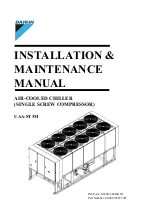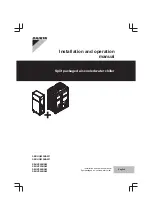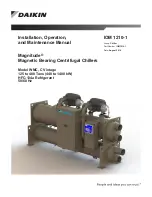
11
UNT-PRC002-GB
Sound power levels
Discharge
Measurement conditions:
Measurements taken in a room adjacent to the room containing the FWD, at the outlet of the rectangular duct (1.5 m
long) fixed to its discharge opening.
Fan
Power level in dB(A), per Hz frequency band
Overall power
Unit
speed
125
250
500
1000
2000
4000
8000
dB(A)
1
55
50
42
37
37
31
30
46
FWD 08
2
57
54
47
40
30
38
40
50
3
58
57
50
42
32
40
43
53
1
57
51
45
42
34
33
28
48
FWD 10
2
58
54
48
45
38
39
35
51
3
60
58
50
48
40
42
39
54
1
57
51
45
42
34
33
28
48
FWD 12
2
58
54
48
45
38
39
35
51
3
60
58
50
48
40
42
39
54
1
56
62
50
48
39
38
36
56
FWD 14
2
61
66
55
53
47
46
45
60
3
63
69
58
56
50
50
49
63
1
57
63
51
49
40
39
37
57
FWD 20
2
61
66
55
53
47
46
45
60
3
63
69
58
56
50
50
49
63
Intake
Measurement conditions:
Measurements taken at the horizontal air intake.
Fan
Power level in dB(A), per Hz frequency band
Overall power
Unit
speed
125
250
500
1000
2000
4000
8000
dB(A)
1
56
55
55
53
46
45
42
57
FWD 08
2
63
62
60
60
53
53
53
64
3
66
65
63
62
56
55
57
67
1
62
58
55
58
51
48
44
61
FWD 10
2
66
63
60
62
56
55
52
66
3
70
67
63
65
59
59
57
69
1
62
58
55
58
51
48
44
61
FWD 12
2
66
63
60
62
56
55
52
66
3
70
67
63
65
59
59
57
69
1
66
65
65
65
57
50
46
68
FWD 14
2
73
72
69
71
64
59
57
74
3
78
76
73
75
69
64
63
78
1
68
72
64
64
56
52
50
69
FWD 20
2
76
76
68
71
65
61
61
75
3
78
79
71
74
69
66
66
78
CG-SVX051A-GB
43
Chilled/hot water freeze protection
Freeze Protection
Depending on the ambient temperature the unit may be
exposed to freeze, there are multiple options for freeze
protection. They are listed in order of highest ambient
(least freeze protection) to the lowest ambient (most
freeze protection).
For all Multi-Pipe units running with water under
cold ambient temperature (below 0°C), it is extremely
important to keep full water flow in the Chilled/Hot Water
for an extended time after last compressor stops. This
will protect chilled/hot water exchanger from freezing
by refrigerant migration. This is why Chilled/Hot Water
Exchanger water pump output relay must be used
to control the water pumps. This is not mandatory if
glycol is used with protection down to lowest ambient
expected.
1. Water pump and heaters
a. Heaters are factory installed on brazed plates
exchangers. They will protect it from freezing in
ambient temperatures down to -18°C. Heaters are
installed on the water piping and on the pumps of
units equipped with hydraulic module.
b. Install heat tape on all water piping, pumps, and
other components that may be damaged if exposed
to freezing temperatures. Heat pump must be
designed for low ambient temperature applications.
Heat tape selection should be based on the lowest
expected ambient temperature.
c. Tracer Symbio™ 800 controller can start the
pump(s) when freezing conditions are detected. For
this option the pumps must be controlled by the
CMAF unit and this function validated on the unit
controller.
a) Water shut off valves need to stay open at all
times.
Note:
Water pump control and heater combination will
protect the Chilled/Hot Water Exchanger down to any
ambient temperature if provided power is available
to the pump and the Tracer Symbio™ 800. This option
will NOT protect the exchangers in the event of power
failure to the unit unless backup power is supplied to the
necessary components.
OR
2. Freeze inhibitor
a. Freeze protection can be accomplished by adding
sufficient glycol to protect against freezing down to
the lowest ambient expected.
b. See “Chilled / hot water exchanger glycol
requirement” section for guidance on determining
the glycol concentration.
Note:
Use of glycol type antifreeze reduces the cooling
capacity of the unit and must be considered in the
design of the system specifications.
CAUTION!
When using freeze inhibitor, never fill the
system with pure glycol.
Always fill the system with diluted solution. Maximum
concentration of glycol is 40%. Higher glycol
concentration will damage pump seal.
OR
3. Drain water circuit
For ambient temperatures below -20°C and for
installation not including either option 1 or 2 above
described.
a. Shut off power supply to unit and to all heaters.
b. Purge the water circuit
c. Blow out the chilled/hot water exchanger to ensure
that no liquid is left inside the Chilled/Hot Water
Exchanger and the water lines. Drain the pump.
Note:
It is not recommended to drain the water circuit for
the following reasons.
1. The water circuit will rust and its lifetime could be
reduced.
2. Water will remain in the bottom of the plate heat
exchangers and freeze damage could occur.
CAUTION! Chilled / hot water exchanger damage!
If insufficient concentration or no glycol is used, the
Chilled/Hot Water Exchanger water pumps must be
controlled by the Tracer Symbio™ 800 to avoid severe
damage to exchangers due to freezing. A power loss of
15 minutes during freezing can damage the exchangers.
It is the responsibility of the installing contractor and/
or the customer to ensure that a pump will start when
called upon by the unit controls. Please consult TRANE
service for unit setting and % of glycol required.
With factory-fitted disconnect switch option, exchanger
trace heating is taken from the live side of the isolator.
As a consequence, the heaters are energized as long as
the main switch is closed. Supply voltage to the heating
tapes is 400V.
•
Avoid the use of very low or near minimum
chilled fluid flow rates through the unit. Higher
velocity chilled fluid flow reduces freeze risk in all
situations.
•
Flow rates below limits have increased freeze
potential and have not been considered by freeze
protection algorithms.
•
Avoid applications and situations that result in
a requirement for rapid cycling or repeated starting
and stopping of the unit. Keep in mind that unit
control algorithms may prevent a rapid compressor
restart after shutting down when the chilled/hot
water exchanger has been operating near by or
below the LRTC (Low Refrigerant Temperature
Cutout) limit.
•
Maintain refrigerant charge at appropriate
levels. If charge is in question, contact Trane service.
A reduced or low level of charge can increase the
likelihood of freezing conditions in the chilled/hot
water exchanger and/or LRTC diagnostic shutdowns.
















































